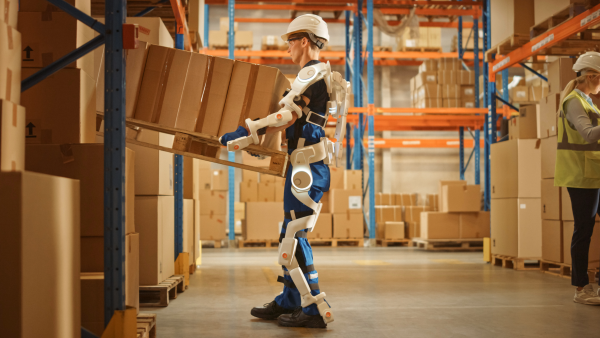How Exoskeletons Can Help Reduce Injuries and Boost Morale

It wasn’t too long ago that solutions like yard management and dock scheduling were considered emerging technologies.
Back then we had to demonstrate and prove how our products, like C3 Reservations, could mesh with your existing warehouse and fulfillment operation and automate many time-consuming and error-prone daily tasks.
Now we’ve passed that phase, and just about everyone is coming to see the value that automation delivers in the distribution centre.
From eliminating repetitive tasks, to digitizing functions like scheduling, the kind of automation we provide with our dock scheduling software makes operations more efficient and easier for your staff.
We thought we’d share a look at a currently evolving technology that looks to be poised for widespread adoption.
Exoskeletons hold the promise of impressive efficiency gains and are being successfully commercialized. And they are purpose-built for warehousing tasks.
What is an exoskeleton?
Exoskeleton technology is a wearable device that allows a human user to have more strength and agility.
In work applications they are typically worn on the upper body and can help workers be more productive while at the same time reducing the risk of injury. In effect, they turn an ordinary worker into a superhuman!
The first record of an exoskeleton was back in 1890, when a researcher won a US patent for a lower limb design.
Later, in the mid-20th century General Electric was working on a full-body exoskeleton that was intended to help the user lift heavy objects.
Subsequently a lot of effort was put into developing the technology to aid people with spinal cord injuries and other disabilities.
Exoskeletons have now been around long enough that they have evolved from simple, passive tools into smarter, powered units.
Notable developments have come from military equipment manufacturers seeking to build a semi-robotic soldier.
Both powered and passive units have been trialed for material handling and industrial uses. Passive systems are popular because they are less complicated, less expensive to produce and lighter.
Some units are capable of allowing the wearer to lift up to 200 pounds repeatedly for up to eight hours at a time without strain or fatigue.
They have the added benefit of being able to shift heavier loads than an unaided human, while still working in tighter spaces than most material handling equipment can navigate.
Injury prevention
Exoskeletons were adopted early on by auto manufacturers eager to find new ways to prevent repetitive strain injuries in their assembly line workers.
Users range from Delta Airlines testing out a robotic unit, to Toyota, Audi and Ford. Swissport won an award in 2019 for its role in developing an exoskeleton.
Subsequently, logistics providers have figured out the benefits of having workers who are able to lift more without tiring, and without hurting themselves. They like having superhumans on staff.
A recent six-month trial at a port in Italy concluded that the exoskeletons they were using – which included an upper body and lumbar support unit – were able to reduce the users’ effort by 30%. And – even better – the workers enthusiastically adopted the suits and recognized how beneficial they could be.
Anybody managing a distribution centre is aware of the frequency and potential severity of injuries workers experience from repetitive strain along with musculoskeletal problems from incorrect lifting bending and twisting.
Musculoskeletal injuries cost your workplace in terms of time off, higher insurance costs, lower morale, staff shortages, and much more.
That’s why it could be worth investigating the potential benefits of trying out exoskeleton technology in your operation.
Keeping your workforce healthy is critical in an environment where staff is hard to find and keep. And, if, like the workers in the Italian port pilot project, your staff find using an exoskeleton fun, then you have a double win.
People will keep coming back to work every shift when they know they won’t get injured AND they can have some fun wearing the ‘superhero’ suit.
Combining new technologies like exoskeletons and advanced automation like C3 Reservations is a sure-fire way to boost your productivity.
The automation reduces the chance of errors, streamlines operations at your docks and ensures that your staff are ready and enabled when a truck shows up for loading or unloading.
With the exoskeletons, they will also be safer, quicker and more productive when dping manual tasks like handbalming.
Labour is hard enough to find these days. Take advantage of automated technology to take some of the pressure off and provide the best working environment you can. It really is a win-win.
To find out more about how C3 Reservations can streamline your operation, contact us for a demo.


